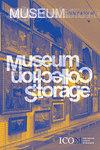Mobilising Collections Storage to Deliver Wide-Ranging Strategic Objectives at the Sedgwick Museum
IF 0.4
4区 艺术学
0 ART
引用次数: 0
Abstract
Abstract Can a new storage facility drive a strategic transformation for a museum? What opportunities does an off-site ‘behind the scenes’ facility provide for developing a museum’s stakeholder relationships and its public engagement role; furthermore, what impact can it have on the social needs of a new community? The Colin Forbes Building is a 650-square-metre facility opened in 2019 by the Sedgwick Museum of Earth Sciences, University of Cambridge, UK, located around 4.5 kilometres from the main museum site in central Cambridge. When fully populated it will provide high-quality, environmentally controlled storage for more than 80 per cent of the Sedgwick’s rock and fossil collections and its unique historic archive. In this case study, we describe how a project conceived to improve storage is now driving a much wider range of strategic initiatives. The project is part of a new Strategic Plan for the Sedgwick Museum, adopted in 2019 and instigated by an external review of the museum’s activities, new leadership and extensive consultation. With the building project itself nearly completed, the challenge lay in mobilising this new facility to contribute to delivery of the aforementioned Strategic Plan. By equipping and presenting it as a dynamic centre for collections-based research we are enabling active development of the Sedgwick’s relationship with the scientific research community. Furthermore, it will enable the Sedgwick to deliver public engagement in ways that enhance the existing ‘traditional’ museum offer. The facility’s location on the edge of a major new community currently under construction on the north-west outskirts of Cambridge, enables us to engage meaningfully with a much wider public and university audience in an area of the city that currently has very little cultural provision. In the context of the Covid-19 pandemic, we review approaches and achievements, and reflect on how the project can continue to support strategic transformation in the post-pandemic period.调动藏品存储以实现塞奇威克博物馆的广泛战略目标
一个新的存储设施能否推动博物馆的战略转型?场外“幕后”设施为发展博物馆的利益相关者关系和公众参与角色提供了什么机会?此外,它会对一个新社区的社会需求产生什么影响?Colin Forbes大楼占地650平方米,由英国剑桥大学塞奇威克地球科学博物馆于2019年开放,距离剑桥市中心的主博物馆约4.5公里。当人口完全饱和时,它将为塞奇威克80%以上的岩石和化石收藏及其独特的历史档案提供高质量、环保的存储。在这个案例研究中,我们描述了一个旨在改进存储的项目现在是如何推动更广泛的战略计划的。该项目是塞奇威克博物馆新战略计划的一部分,该计划于2019年通过,由博物馆活动的外部审查、新的领导和广泛的咨询推动。随着建筑项目本身接近完成,挑战在于动员这个新设施为上述战略计划的交付做出贡献。通过装备和展示它作为一个充满活力的以收藏为基础的研究中心,我们正在积极发展塞奇威克与科学研究界的关系。此外,它将使塞奇威克博物馆能够以增强现有“传统”博物馆的方式提供公众参与。该设施位于剑桥西北郊区正在建设的一个主要新社区的边缘,使我们能够在目前文化设施很少的城市地区与更广泛的公众和大学观众进行有意义的接触。在2019冠状病毒病大流行背景下,我们回顾了方法和成果,并思考该项目如何继续支持大流行后时期的战略转型。
本文章由计算机程序翻译,如有差异,请以英文原文为准。
求助全文
约1分钟内获得全文
求助全文
来源期刊

MUSEUM INTERNATIONAL
ART-
CiteScore
0.60
自引率
0.00%
发文量
0
期刊介绍:
In its new revised form Museum International is a forum for intellectually rigorous discussion of the ethics and practices of museums and heritage organizations. The journal aims to foster dialogue between research in the social sciences and political decision-making in a changing cultural environment. International in scope and cross-disciplinary in approach Museum International brings social-scientific information and methodology to debates around museums and heritage, and offers recommendations on national and international cultural policies.
 求助内容:
求助内容: 应助结果提醒方式:
应助结果提醒方式:


